2013 KIA CEED wheel alignment
[x] Cancel search: wheel alignmentPage 178 of 1168
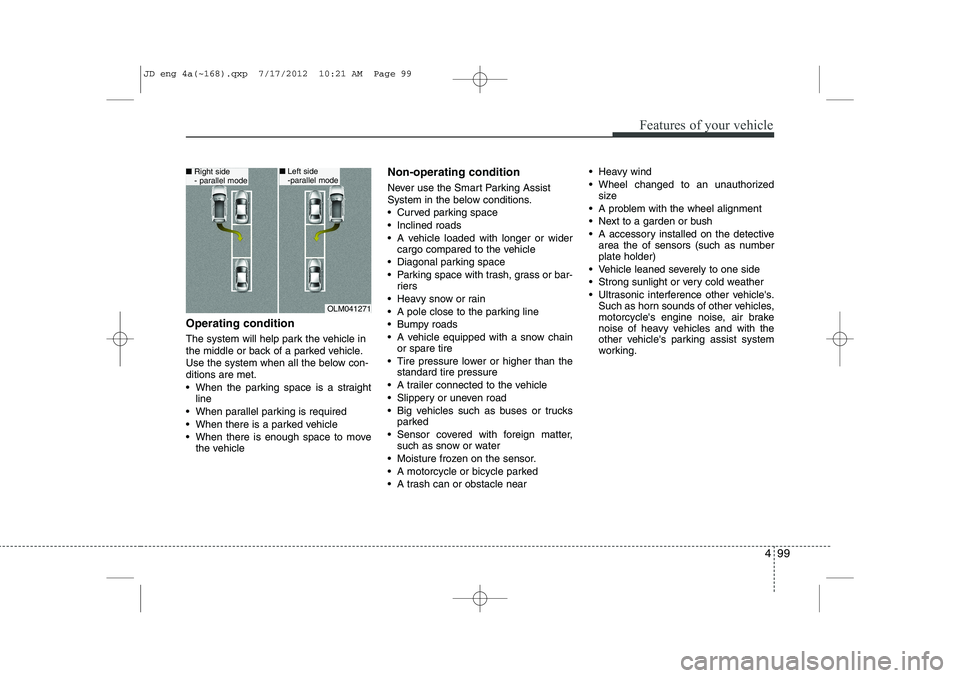
499
Features of your vehicle
Operating condition
The system will help park the vehicle in
the middle or back of a parked vehicle.
Use the system when all the below con-ditions are met.
When the parking space is a straightline
When parallel parking is required
When there is a parked vehicle
When there is enough space to move the vehicle Non-operating condition
Never use the Smart Parking Assist
System in the below conditions.
Curved parking space
Inclined roads
A vehicle loaded with longer or wider
cargo compared to the vehicle
Diagonal parking space
Parking space with trash, grass or bar- riers
Heavy snow or rain
A pole close to the parking line
Bumpy roads
A vehicle equipped with a snow chain or spare tire
Tire pressure lower or higher than the standard tire pressure
A trailer connected to the vehicle
Slippery or uneven road
Big vehicles such as buses or trucks parked
Sensor covered with foreign matter, such as snow or water
Moisture frozen on the sensor.
A motorcycle or bicycle parked
A trash can or obstacle near Heavy wind
Wheel changed to an unauthorized
size
A problem with the wheel alignment
Next to a garden or bush
A accessory installed on the detective area the of sensors (such as number plate holder)
Vehicle leaned severely to one side
Strong sunlight or very cold weather
Ultrasonic interference other vehicle's. Such as horn sounds of other vehicles,
motorcycle's engine noise, air brake
noise of heavy vehicles and with the
other vehicle's parking assist system
working.
OLM041271
■Right side
- parallel mode■Left side
-parallel mode
JD eng 4a(~168).qxp 7/17/2012 10:21 AM Page 99
Page 403 of 1168
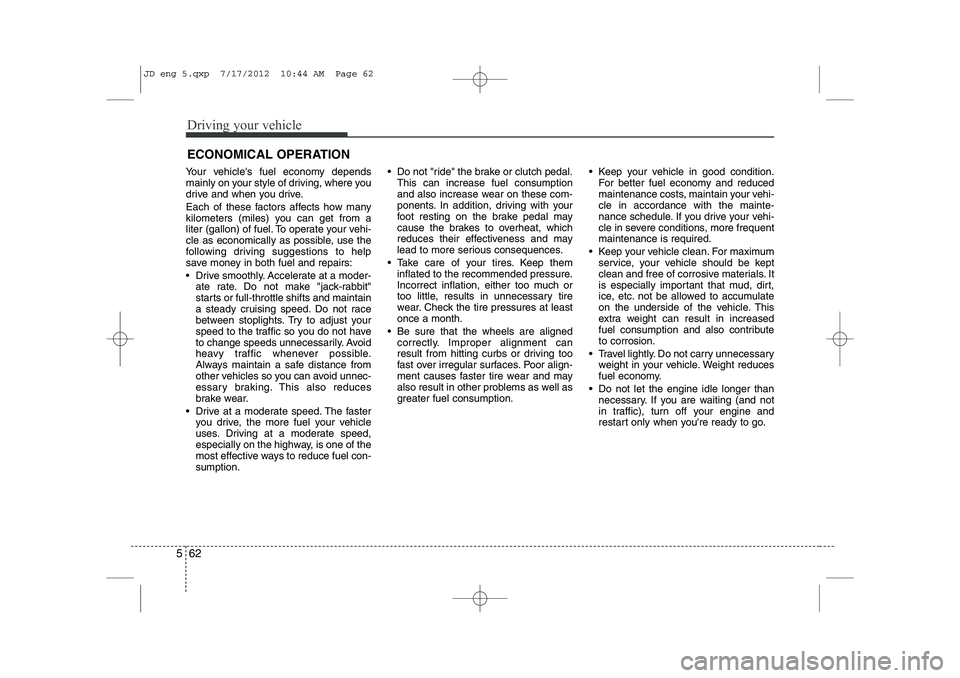
Driving your vehicle
62
5
ECONOMICAL OPERATION
Your vehicle's fuel economy depends
mainly on your style of driving, where you
drive and when you drive.
Each of these factors affects how many
kilometers (miles) you can get from a
liter (gallon) of fuel. To operate your vehi-
cle as economically as possible, use the
following driving suggestions to help
save money in both fuel and repairs:
Drive smoothly. Accelerate at a moder- ate rate. Do not make "jack-rabbit"
starts or full-throttle shifts and maintain
a steady cruising speed. Do not race
between stoplights. Try to adjust your
speed to the traffic so you do not have
to change speeds unnecessarily. Avoid
heavy traffic whenever possible.
Always maintain a safe distance from
other vehicles so you can avoid unnec-
essary braking. This also reduces
brake wear.
Drive at a moderate speed. The faster you drive, the more fuel your vehicle
uses. Driving at a moderate speed,
especially on the highway, is one of the
most effective ways to reduce fuel con-sumption. Do not "ride" the brake or clutch pedal.
This can increase fuel consumption
and also increase wear on these com-
ponents. In addition, driving with your
foot resting on the brake pedal may
cause the brakes to overheat, which
reduces their effectiveness and may
lead to more serious consequences.
Take care of your tires. Keep them inflated to the recommended pressure.
Incorrect inflation, either too much or
too little, results in unnecessary tire
wear. Check the tire pressures at leastonce a month.
Be sure that the wheels are aligned correctly. Improper alignment can
result from hitting curbs or driving too
fast over irregular surfaces. Poor align-
ment causes faster tire wear and may
also result in other problems as well as
greater fuel consumption. Keep your vehicle in good condition.
For better fuel economy and reduced
maintenance costs, maintain your vehi-cle in accordance with the mainte-
nance schedule. If you drive your vehi-
cle in severe conditions, more frequentmaintenance is required.
Keep your vehicle clean. For maximum service, your vehicle should be kept
clean and free of corrosive materials. It
is especially important that mud, dirt,
ice, etc. not be allowed to accumulate
on the underside of the vehicle. This
extra weight can result in increased
fuel consumption and also contributeto corrosion.
Travel lightly. Do not carry unnecessary weight in your vehicle. Weight reduces
fuel economy.
Do not let the engine idle longer than necessary. If you are waiting (and not
in traffic), turn off your engine and
restart only when you're ready to go.
JD eng 5.qxp 7/17/2012 10:44 AM Page 62
Page 461 of 1168
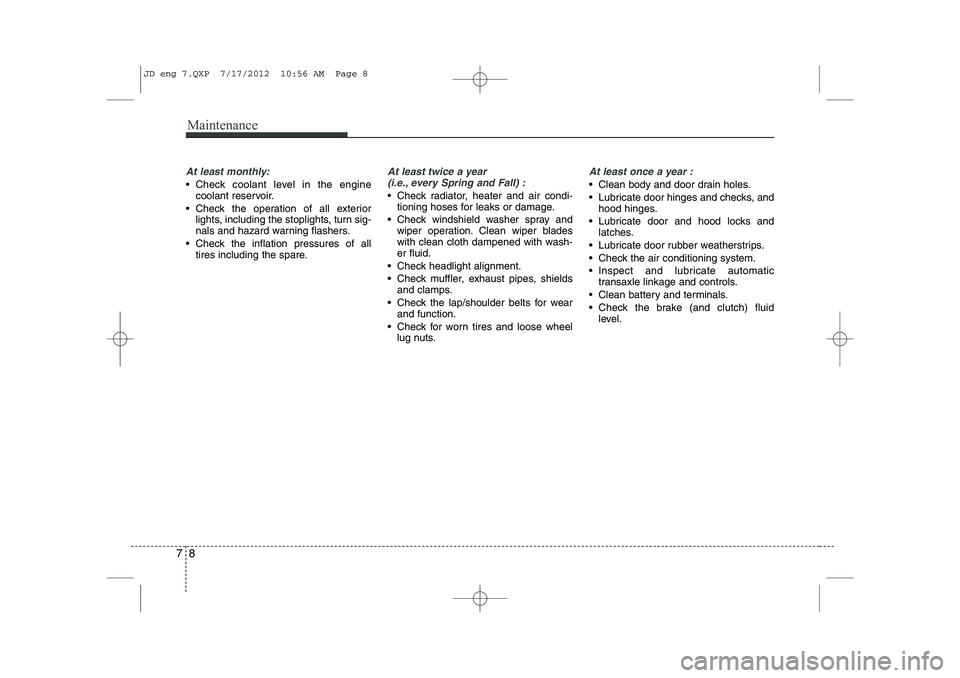
Maintenance
8
7
At least monthly:
Check coolant level in the engine
coolant reservoir.
Check the operation of all exterior lights, including the stoplights, turn sig-
nals and hazard warning flashers.
Check the inflation pressures of all tires including the spare.
At least twice a year
(i.e., every Spring and Fall) :
Check radiator, heater and air condi- tioning hoses for leaks or damage.
Check windshield washer spray and wiper operation. Clean wiper blades
with clean cloth dampened with wash-er fluid.
Check headlight alignment.
Check muffler, exhaust pipes, shields and clamps.
Check the lap/shoulder belts for wear and function.
Check for worn tires and loose wheel lug nuts.
At least once a year :
Clean body and door drain holes.
Lubricate door hinges and checks, andhood hinges.
Lubricate door and hood locks and latches.
Lubricate door rubber weatherstrips.
Check the air conditioning system.
Inspect and lubricate automatic transaxle linkage and controls.
Clean battery and terminals.
Check the brake (and clutch) fluid level.
JD eng 7.QXP 7/17/2012 10:56 AM Page 8
Page 509 of 1168
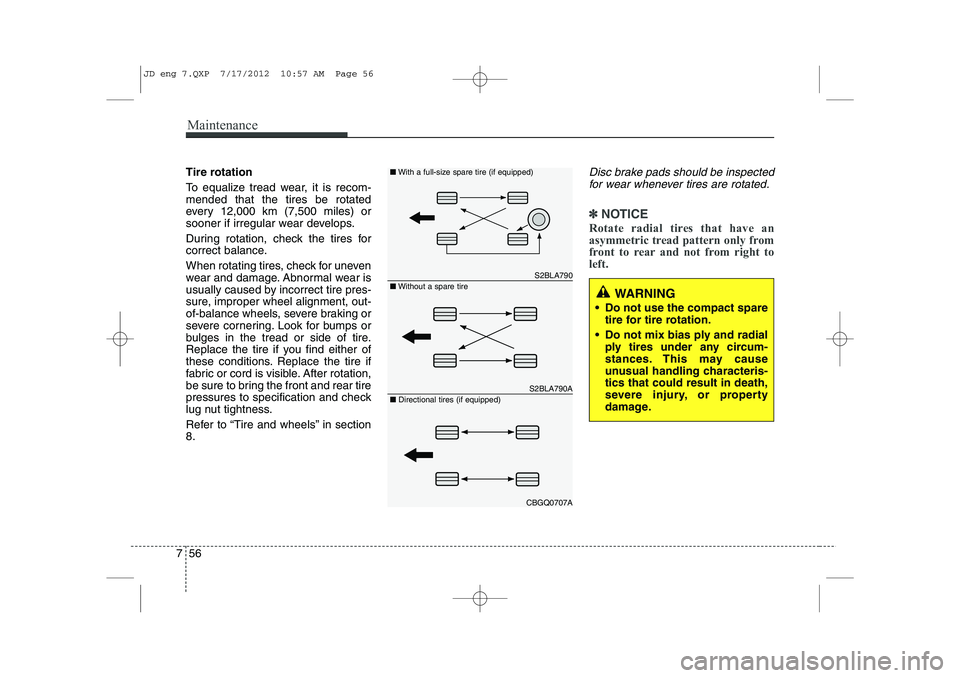
Maintenance
56
7
Tire rotation
To equalize tread wear, it is recom- mended that the tires be rotated
every 12,000 km (7,500 miles) or
sooner if irregular wear develops.
During rotation, check the tires for
correct balance.
When rotating tires, check for uneven
wear and damage. Abnormal wear is
usually caused by incorrect tire pres-
sure, improper wheel alignment, out-
of-balance wheels, severe braking or
severe cornering. Look for bumps or
bulges in the tread or side of tire.
Replace the tire if you find either of
these conditions. Replace the tire if
fabric or cord is visible. After rotation,
be sure to bring the front and rear tire
pressures to specification and check
lug nut tightness.
Refer to “Tire and wheels” in section 8.Disc brake pads should be inspected
for wear whenever tires are rotated.
✽✽ NOTICE
Rotate radial tires that have an
asymmetric tread pattern only from
front to rear and not from right toleft.
WARNING
Do not use the compact spare tire for tire rotation.
Do not mix bias ply and radial ply tires under any circum-
stances. This may cause
unusual handling characteris-tics that could result in death,
severe injury, or property
damage.
S2BLA790
S2BLA790A
CBGQ0707A
■Without a spare tire
■
With a full-size spare tire (if equipped)
■ Directional tires (if equipped)
JD eng 7.QXP 7/17/2012 10:57 AM Page 56
Page 510 of 1168
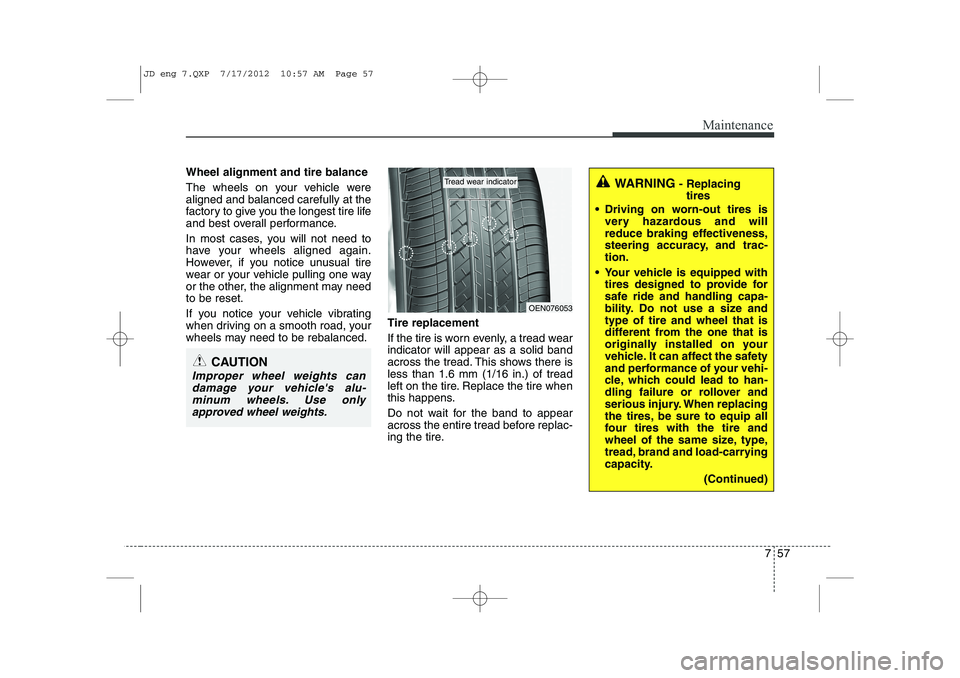
757
Maintenance
Wheel alignment and tire balance
The wheels on your vehicle were aligned and balanced carefully at the
factory to give you the longest tire life
and best overall performance.
In most cases, you will not need to
have your wheels aligned again.
However, if you notice unusual tire
wear or your vehicle pulling one way
or the other, the alignment may needto be reset.
If you notice your vehicle vibrating
when driving on a smooth road, your
wheels may need to be rebalanced.Tire replacement
If the tire is worn evenly, a tread wear indicator will appear as a solid band
across the tread. This shows there isless than 1.6 mm (1/16 in.) of tread
left on the tire. Replace the tire when
this happens.
Do not wait for the band to appear
across the entire tread before replac-
ing the tire.
CAUTION
Improper wheel weights can
damage your vehicle's alu-minum wheels. Use only approved wheel weights.
WARNING - Replacing
tires
Driving on worn-out tires is very hazardous and will
reduce braking effectiveness,
steering accuracy, and trac-tion.
Your vehicle is equipped with tires designed to provide for
safe ride and handling capa-
bility. Do not use a size andtype of tire and wheel that is
different from the one that is
originally installed on your
vehicle. It can affect the safety
and performance of your vehi-
cle, which could lead to han-
dling failure or rollover and
serious injury. When replacing
the tires, be sure to equip all
four tires with the tire and
wheel of the same size, type,
tread, brand and load-carrying
capacity.
(Continued)
OEN076053
Tread wear indicator
JD eng 7.QXP 7/17/2012 10:57 AM Page 57
Page 512 of 1168
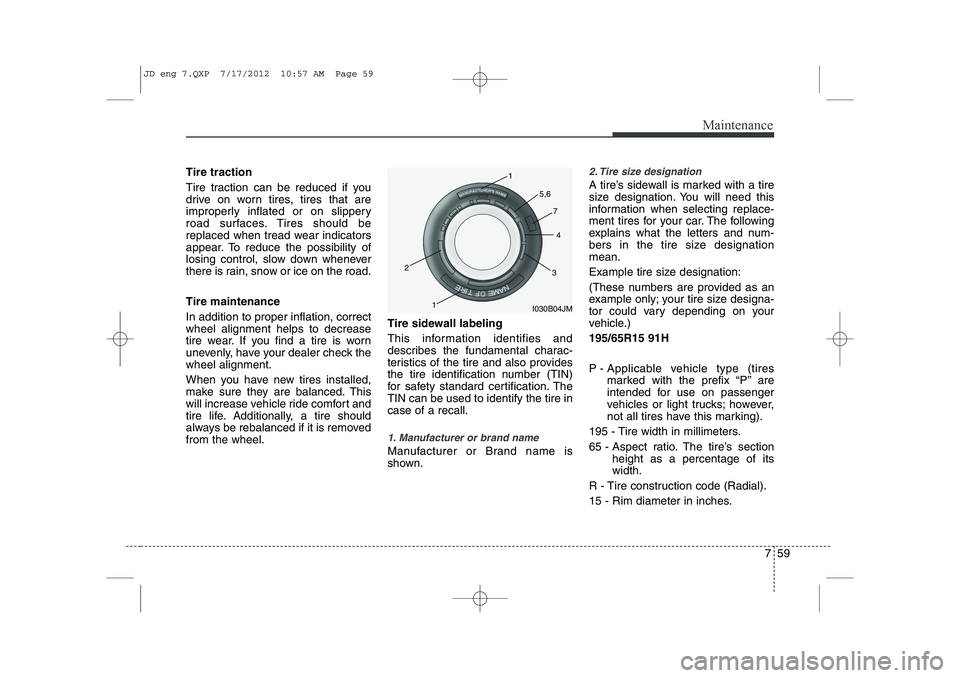
759
Maintenance
Tire traction
Tire traction can be reduced if you
drive on worn tires, tires that are
improperly inflated or on slippery
road surfaces. Tires should be
replaced when tread wear indicators
appear. To reduce the possibility of
losing control, slow down whenever
there is rain, snow or ice on the road. Tire maintenance In addition to proper inflation, correct wheel alignment helps to decrease
tire wear. If you find a tire is worn
unevenly, have your dealer check thewheel alignment.
When you have new tires installed,
make sure they are balanced. This
will increase vehicle ride comfort and
tire life. Additionally, a tire should
always be rebalanced if it is removedfrom the wheel.Tire sidewall labeling
This information identifies and
describes the fundamental charac-
teristics of the tire and also provides
the tire identification number (TIN)
for safety standard certification. TheTIN can be used to identify the tire incase of a recall.
1. Manufacturer or brand name
Manufacturer or Brand name is
shown.
2. Tire size designation
A tire’s sidewall is marked with a tire
size designation. You will need this
information when selecting replace-
ment tires for your car. The following
explains what the letters and num-
bers in the tire size designationmean.
Example tire size designation:
(These numbers are provided as an
example only; your tire size designa-
tor could vary depending on your
vehicle.) 195/65R15 91H
P - Applicable vehicle type (tires
marked with the prefix “P’’ are
intended for use on passenger
vehicles or light trucks; however,
not all tires have this marking).
195 - Tire width in millimeters.
65 - Aspect ratio. The tire’s section height as a percentage of its width.
R - Tire construction code (Radial).
15 - Rim diameter in inches.
I030B04JM
1
1
2
34
5,6
7
JD eng 7.QXP 7/17/2012 10:57 AM Page 59
Page 583 of 1168

Index
12
I
Tachometer (Normal vision) . . . . . . . . . . . . . . . . . . . 4-47
Tachometer (Super vision) . . . . . . . . . . . . . . . . . . . . . 4-60
Tailgate . . . . . . . . . . . . . . . . . . . . . . . . . . . . . . . . . . . . . 4-22
Tether anchor system . . . . . . . . . . . . . . . . . . . . . . . . . 3-34
Theft-alarm system . . . . . . . . . . . . . . . . . . . . . . . . . . . 4-14
Tilt & telescopic steering . . . . . . . . . . . . . . . . . . . . . . 4-38
Tire chains . . . . . . . . . . . . . . . . . . . . . . . . . . . . . . . . . . 5-68
Tire pressure monitoring system (TPMS) . . . . . . . . 6-23
Tire rotation . . . . . . . . . . . . . . . . . . . . . . . . . . . . . . . . 7-56
Tire specification and pressure label . . . . . . . . . . . . 8-10
Tires and wheels . . . . . . . . . . . . . . . . . . . . . . . . . 7-53, 8-5
Checking tire inflation pressure . . . . . . . . . . . . . . . 7-55
Compact spare tire replacement . . . . . . . . . . . . . . . 7-58
Recommended cold tire inflation pressures . . . . . . 7-53
Tire care. . . . . . . . . . . . . . . . . . . . . . . . . . . . . . . . . . . 7-53
Tire maintenance . . . . . . . . . . . . . . . . . . . . . . . . . . . 7-59
Tire replacement . . . . . . . . . . . . . . . . . . . . . . . . . . . . 7-57
Tire rotation . . . . . . . . . . . . . . . . . . . . . . . . . . . . . . . 7-56
Tire sidewall labeling . . . . . . . . . . . . . . . . . . . . . . . . 7-59
Tire traction . . . . . . . . . . . . . . . . . . . . . . . . . . . . . . . 7-59
Wheel alignment and tire balance . . . . . . . . . . . . . 7-57
Wheel replacement . . . . . . . . . . . . . . . . . . . . . . . . . . 7-58
Towing . . . . . . . . . . . . . . . . . . . . . . . . . . . . . . . . . . . . . 6-28
Trailer towing . . . . . . . . . . . . . . . . . . . . . . . . . . . . . . . 5-71 Transaxle
Automatic transaxle/DCT . . . . . . . . . . . . . . . . . . . . 5-23
Double clutch transmission . . . . . . . . . . . . . . . . . . . 5-23
Manual transaxle . . . . . . . . . . . . . . . . . . . . . . . . . . . 5-20
Trip computer (Normal vision) . . . . . . . . . . . . . . . . . 4-51
Service mode . . . . . . . . . . . . . . . . . . . . . . . . . . . . . . . 4-55
User Settings . . . . . . . . . . . . . . . . . . . . . . . . . . . . . . . 4-56
Trip computer (Super vision) . . . . . . . . . . . . . . . . . . 4-64
Driving information mode . . . . . . . . . . . . . . . . . . . . 4-65
Lane Departure Warning System Mode . . . . . . . . 4-67
Service mode . . . . . . . . . . . . . . . . . . . . . . . . . . . . . . . 4-68
User Settings . . . . . . . . . . . . . . . . . . . . . . . . . . . . . . . 4-69
Turn signals . . . . . . . . . . . . . . . . . . . . . . . . . . . . . . . . 4-114
User Settings (Normal vision) . . . . . . . . . . . . . . . . . . 4-56
User Settings (Super vision) . . . . . . . . . . . . . . . . . . . . 4-69
Vanity mirror lamp . . . . . . . . . . . . . . . . . . . . . . . . . . 4-123
Vehicle break-in process . . . . . . . . . . . . . . . . . . . . . . . . 1-5
Vehicle certification label . . . . . . . . . . . . . . . . . . . . . . . 8-9
Vehicle identification number (VIN). . . . . . . . . . . . . . 8-9
Vehicle stability management . . . . . . . . . . . . . . . . . . 5-47
Vehicle weight . . . . . . . . . . . . . . . . . . . . . . . . . . . . . . . 5-80
U
V
T
JD eng Index.qxp 7/21/2012 11:45 AM Page 12
Page 584 of 1168

I13
Index
Warning and indicators . . . . . . . . . . . . . . . . . . . . . . . 4-77
Washer fluid . . . . . . . . . . . . . . . . . . . . . . . . . . . . . . . . 7-41
Weight/volume. . . . . . . . . . . . . . . . . . . . . . . . . . . . . . . . 8-3
Welcome system . . . . . . . . . . . . . . . . . . . . . . . . . . . . 4-125
Wheel alignment and tire balance. . . . . . . . . . . . . . . 7-57
Wheel replacement . . . . . . . . . . . . . . . . . . . . . . . . . . . 7-58
Windows . . . . . . . . . . . . . . . . . . . . . . . . . . . . . . . . . . . 4-24
Manual windows . . . . . . . . . . . . . . . . . . . . . . . . . . . . 4-27
Power window lock button . . . . . . . . . . . . . . . . . . . 4-26
Power windows . . . . . . . . . . . . . . . . . . . . . . . . . . . . . 4-25
Windshield defrosting and defogging . . . . . . . . . . . 4-148 Auto defogging system . . . . . . . . . . . . . . . . . . . . . . 4-149
Windshield washers . . . . . . . . . . . . . . . . . . . . . . . . . 4-120
Windshield wipers . . . . . . . . . . . . . . . . . . . . . . . . . . . 4-118
Winter driving . . . . . . . . . . . . . . . . . . . . . . . . . . . . . . . 5-67 Snow tires . . . . . . . . . . . . . . . . . . . . . . . . . . . . . . . . . 5-67
Tire chains . . . . . . . . . . . . . . . . . . . . . . . . . . . . . . . . . 5-68
Wiper blades . . . . . . . . . . . . . . . . . . . . . . . . . . . . . . . . 7-47
Wipers and washers . . . . . . . . . . . . . . . . . . . . . . . . . 4-118 Front indshield wipers . . . . . . . . . . . . . . . . . . . . . . 4-118
Front windshield washers . . . . . . . . . . . . . . . . . . . 4-120
Headlight washer . . . . . . . . . . . . . . . . . . . . . . . . . . 4-121
Rear window wiper . . . . . . . . . . . . . . . . . . . . . . . . 4-121
W
JD eng Index.qxp 7/21/2012 11:45 AM Page 13